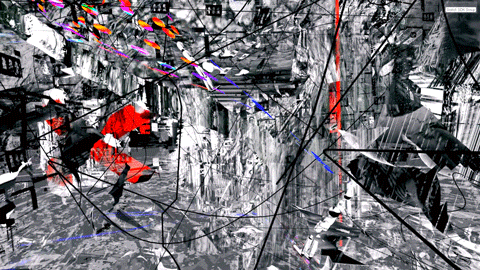Borrowed Scenery 借 景
2019
Medium
5 – 10 minutes Virtual Reality Experience
Selected Exhibitions
IEEE VISAP, Vancouver Convention Center, Canada / 2019
M.A.D.E, CNSI, Santa Barbara / 2019

Borrowed Scenery is a strategy to incorporate distant vista into the composition of a garden. Jicheng, a Chinese garden designer in the Ming dynasty (1582 – c. 1642) pointed out in The Garden Treatise (园冶)that the appearance of the landscape and the garden maker are both object and subject, which is interchangeable. Grew up in the most famous Chinese garden city, Suzhou, I am interested in incorporating this idea into the spatial arrangement in the VR space.
Borrowed Scenery is a virtual reality experience that constructs an autobiographical spatial narrative that points to the deconstruction and reconstruction of cultural identity through experimental visualization of image data.
Being exposed to diverse cultures enables us to continuously portray our own cultural identities through collaging our collective memories cross cultural boundaries. In this project, I utilized autobiographical threads to evoke the universal experience of alienation and displacement. Photographs of eastern and western motifs, symbols and landscapes, which are collected as raw source image data, are captured volumetrically mostly in two places - my hometown Suzhou (China) and my current living place Los Angeles (US). Visualizing those two groups of image data in the VR world change the way we percept the scalability of intersections, as we could navigate the space to play with different points of view. A non-linear narrative is created when the intelligent agents ( generated by image data) crossed over dynamically in the virtual world.
The visualization methodology includes photogrammetry, shader programming, and intelligent system development. The pixel coordinates from those sets of image data are reconstructed as 3d coordinates of points on structures through automatic calibration. A customized shader is designed for the textures of those data-driven structures, which displaces and animates processed image pixels on vertices with layers of customized algorithms and 3d Voronoi Tessellation, collectively generates fragmental geometrical forms and fluid chaos. Those forms are programmed as intelligent agents to seek and wander in the environment, collide with others, die and get reborn. The system simulates how our cultural identities are evolved and how the ‘border’ is dynamically disturbed and reformed in the aesthetic and subject matter.
The whole space could be interpreted as a data-driven photomontage, an autonomous agent-based system, a bank of collective memories, a tiling puzzle with over 50 thousand tessellating pieces, and ultimately a shared state of ideas, values, and language across the boundaries.
User Interaction
The duration of this Virtual Reality experience is 5 - 10 minutes. Each audience could participate in this immersive audio-visual experience by wearing a VR headset and using a controller to navigate the space. During the virtual experience, the audience could fly to different places with diverse sounds and visuals, interacting with intelligent fragments, and affecting their appearance, sounds, and behaviors, which will result in an ever-changing fluid space. The audience will wander in the space, be curious about the meaning of the textures, symbols, and structures, engage in the interaction, and rethink the issue of cultural identity, personal displacement, and alienation.
Special Thanks to



